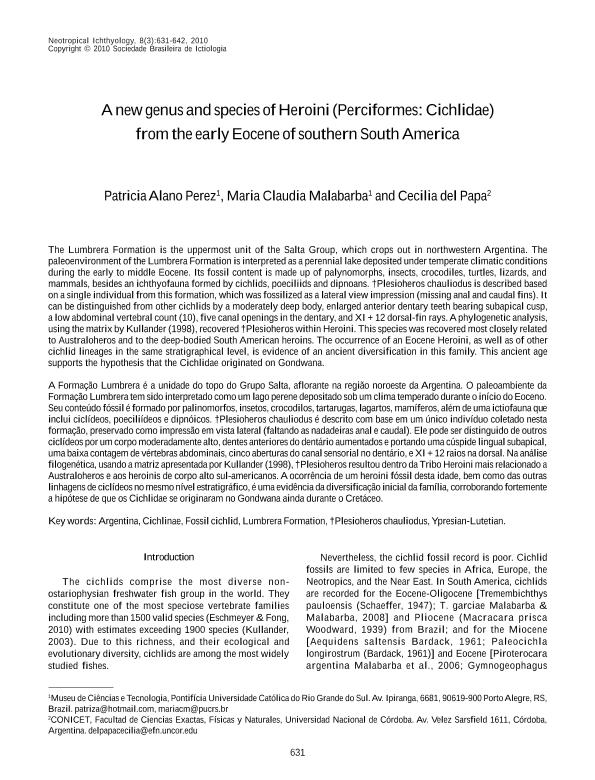Artículo
A new genus and species of Heroini (Perciformes: Cichlidae) from the early Eocene of southern South America
Fecha de publicación:
11/2010
Editorial:
Sociedade Brasileira de Ictiologia
Revista:
Neotropical Ichthyology
ISSN:
1679-6225
e-ISSN:
1982-0224
Idioma:
Inglés
Tipo de recurso:
Artículo publicado
Clasificación temática:
Resumen
The Lumbrera Formation is the uppermost unit of the Salta Group, which crops out in northwestern Argentina. The paleoenvironment of the Lumbrera Formation is interpreted as a perennial lake deposited under temperate climatic conditions
during the early to middle Eocene. Its fossil content is made up of palynomorphs, insects, crocodiles, turtles, lizards, and mammals, besides an ichthyofauna formed by cichlids, poeciliids and dipnoans. †Plesioheros chauliodus is described based
on a single individual from this formation, which was fossilized as a lateral view impression (missing anal and caudal fins). It can be distinguished from other cichlids by a moderately deep body, enlarged anterior dentary teeth bearing subapical cusp,
a low abdominal vertebral count (10), five canal openings in the dentary, and XI + 12 dorsal-fin rays. A phylogenetic analysis, using the matrix by Kullander (1998), recovered †Plesioheros within Heroini. This species was recovered most closely related to Australoheros and to the deep-bodied South American heroins. The occurrence of an Eocene Heroini, as well as of other cichlid lineages in the same stratigraphical level, is evidence of an ancient diversification in this family. This ancient age supports the hypothesis that the Cichlidae originated on Gondwana.
Palabras clave:
Argentina
,
Cichlinae
,
Fossil Cichlid
,
Lumbrera Formation
Archivos asociados
Licencia
Identificadores
Colecciones
Articulos(CICTERRA)
Articulos de CENTRO DE INVEST.EN CS.DE LA TIERRA
Articulos de CENTRO DE INVEST.EN CS.DE LA TIERRA
Citación
Perez, Patricia Alano; Malabarba, Maria Claudia; del Papa, Cecilia Eugenia; A new genus and species of Heroini (Perciformes: Cichlidae) from the early Eocene of southern South America; Sociedade Brasileira de Ictiologia; Neotropical Ichthyology; 8; 3; 11-2010; 631-642
Compartir
Altmétricas




